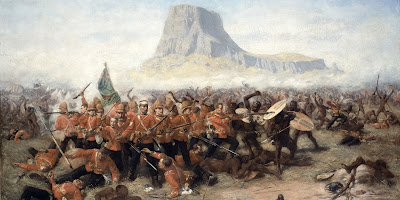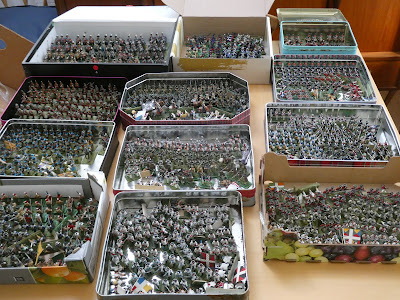On Saturday afternoon I braved the torrential rain showers which broke our recent heatwave, for a trip to the National Army Museum, Chelsea. Their current exhibition is called Myth and Reality: Military Art in the Age of Queen Victoria , and a series of talks were run during the day in support of it. I booked for one of them - Military Art of the Zulu War, given by Ian Knight. As many of you will know, Ian is THE expert on Zulu military history - I just checked, and found that I have a series of articles by him starting in issue 16 of Miniature Wargames magazine, from 1984! I am no expert on the Zulus (clearly I have failed to read all those articles!), but it's always worth hearing someone who really knows their subject - and so it proved. Please excuse my poor-quality phone picture of Ian in full flow ( well, it was 'darkest Africa', I suppose)
The museum website described the talk like this :
Ian Knight examines artistic representations of the Zulu War of 1879 and how they continue to influence our understanding of the conflict today.
The Zulu War was fought between the British Empire and the Zulu Kingdom in the furthest reaches of southern Africa. The Zulus demonstrated remarkable resilience, and the war became notable for its ferocious battles. Today, the conflict holds a prominent place in Britain’s collective memory of colonial warfare.
Artists of the time attempted to influence opinion of the Army and its exploits against the Zulus. Charles Edwin Fripp’s romanticised depiction of the British defeat at Isandlwana failed to capture the Victorian public’s imagination. But paintings of the successful defence of Rorke’s Drift by Lady Elizabeth Butler and Alphonse de Neuville proved more popular. Butler’s piece in particular attracted a ‘great crush’ of onlookers at the Royal Academy of Arts in 1881.
As part of our Victorian Soldier Spotlight, historian Ian Knight will examine the different ways that artists of the era portrayed the Zulu War, showing how their work has helped these events to enter British folklore.
Ian is a good, very articulate but unstuffy speaker and gave us a 75-minute tour of his subject (over-running by 15 minutes, but no-one minded!). I didn't take notes, but can remember some sailent points and will try to give them here.
The Anglo-Zulu War of 1879 was essentially an unprovoked invasion of the Zulu Kingdom by British forces led by Lord Chelmsford. How was it portrayed back in Britain? Well, photography was possible but difficult, as photographers still needed to transport bulky kit and chemicals, and the war zone was isolated and undeveloped - and a war zone! So 'action' photos were rare, though pictures of British troops and some Zulu prisoners were made in camps well away from the front. Even if photographs had been easily available, the newspapers of the time could not print them; they relied on drawings and sketches sent back from the war, which would then be turned into engravings for publication in The Daily Graphic, Illustrated London News etc. Ian showed us a pencil sketch (see below) made by Melton Prior at the battlefield of Isandlwana about a month after the event, and the published engraving made from it - from which the original's images of dead and decaying British soldiers were of course omitted.
There was of course a lot of public interest in the war, and this soon led to the commissioning of paintings recording the main events - these would be put on public display and could draw large crowds to view them. Ian took us through some of these, and pointed out salient features:
First out of the blocks was this, Siege of Rorke's Drift by William Henry Dugan:
 |
| From Art UK (Image credit: The Regimental Museum of The Royal Welsh ) |
This was painted in 1879, quite soon after the event and when very little information was available -which explains why you little or no detail of the location! Ian pointed out that the Zulus are not accurately portrayed - the artist just didn't have sufficient information.
As timew went by, a lot more detail of the events of the battle became available and could be included in paintings. In 1880, French artist Alphonse de Neuville produced The Defence of Rorke's Drift 1879' ( French artists seemed to feature prominently; it seems many had learned their craft depicting the events of 1870-71 ).
Ian pointed out that this sort of picture works a bit like a film - it includes many different episodes which people would have read about in the newspapers: Chaplain Smith handing out ammunition; Surgeon Reynolds attending to wounded; Lieutenants Chard and Bromhead, the highest-ranking officers present; the hospital set on fire by the Zulus and wounded being carried out, etc. All these incidents are included in the picture, though they actually took place at different times during the 12-hour siege. Notice of course, that events are seen very much through British eyes - the Zulu attackers are barely visible, the focus is of course entirely on the heroic British defenders.
However, it seems that Queen Victoria was not too impressed with a Frenchman producing the definitive representation of a British battle, so she commissioned a British artist to paint the same subject. This was Lady Elizabeth Butler, whose The Defence of Rorke's Drift was also painted in 1880.
In many ways a similar approach to de Neuville, with several of the well-known characters on view : Chard and Bromhead (both VC) right at the Centre, Chaplain Smith behind them, wounded Private Frederick Hitch (VC) in right foreground, also handing out ammunition, Surgeon Reynolds ( in black) attending to wounded, his assistant Storekeeper Byrne dramatically falling, shot, and Corporal Ferdinand Schiess (VC) climing onto the barricade to use his bayonet (khaki uniform, to left of the officers ). Plus of course the hospital on fire, and wounded being escorted away, and again of course the Zulus don;t get much of a look-in, all the focus is on 'our brave boys'. Many of these men had been interviewed by Lady Butler, and showed her the uniforms they wore at the battle - though Ian pointed out that Bromhead and Chard would very likely have worn full beards on campaign, which would then have been shaved off on their return to Britain. The painting attracted large crowds when put on public display, and you too can now see it 'in the flesh', as it has fairly recently been cleaned and restored, and is part of the exhibition at the NAM. Well worth looking at it full-size and in person!
The final battle of the war, and the final defeat of the Zulus, was at Ulundi, in July 1879, and of course there is a large-scale painting of it, which belongs to the National Army Museum collection; it was for some years on display on the wall of a corridor in the museum This is The Battle of Ulundi by Adolphe Yvon ( another Frenchman!) , also painted in 1880.
Ian said he had been puzzled for a while, as the picture seems to show the British force in a battle line, whereas in fact Lord Chelmsford drew up his army in a large square formation; it seems that the painting was most probably painted as a 'panorma', designed to be displayed on the wall of circular chamber, with the audience at the centre. That would explain, for example, the way that the smoke of battle seems to be drifting in different directions(!). Also note one or two dark-coated British lancers at the bottom left - these would be from the 17th Lancers, who charged in pursuit of the fleeing Zulus. A few years ago, he said, he was shown a painting in South Africa depicting the 17th at Ulundi, and realised that it was probably a missing panel from this picture, showing the 17th about to charge.
Of course the other famous event of the Zulu War was the catastrophic defeat of Chelmsford's army at Isandlwana, on the same day as Rorke's Drift, and this too has been the subect of several artworks, the most famous being by Charles Edwin Fripp, first exhibited in 1885:
Perhaps unsurprisingly, this picture was not as popular as the Rorke's Drift paintings - the public were much more keen on the latter miraculous victory than this disastrous defeat! Ian talked us through some interesting points. As ever, the focus is on our brave boys, who must be seen as heroic even in defeat, hence the 'last stand' nature of the foreground group, though the background scenes of slaughter would probably be more like the reality, One detail he pointed out was the young drummer boy in the left centre, when in fact the British drummers would have been adults. Also note that there are no officers shown - so the heroic other ranks are left to 'do and die' by their incompetent (and fleeing ) officers? This painting also belongs to the National Army Museum, and they have a web page about its recent restoration.
The attempts to find consolation in catastprophe continued in several other contemporary paintings which focussed especially on the story of Lieutenants Teignmouth Melvill and Nevill Coghill, who were killed attempting to save the Queen's Colour of the 1st Battalion, 24th Foot.- as Wikipedia puts it , the colour was carried off the field by Lieutenant Melvill on horseback but lost when he crossed the river, despite Lieutenant Coghill having come to his aid. Both Melvill and Coghill were killed after crossing the river, and received posthumous Victoria Crosses in 1907 as the legend of their gallantry grew. Here is Last Sleep of the Brave by Alphonse de Neuville (1881) - Lancers find the bodies of the dead heroes, united in death and still protecting the colours:.
Except, as Ian Knight pointed out, the bodies were found some distance apart, the colours were not saved but dropped in the river, and that's the wrong colours in the picture!And what about the poor old Zulus in all this? As stated already, the paintings tend to show the heroics of the redcoats, and ignore the zulus and their point of viw- at least partly, it seems because artists had little first-hand knowledge of them and their appearance and equipment. Ian as able to show us one image of Rorkes Drift, drawn from a viewpoint amongst the Zulu army - I haven't been able to find a copy of that one, but it was, Ian said, almost certainly based on this watercolour sketch made by Lieutenant Chard, who was in command on the day :
And finally, I think Ian said that this drawing, A Zulu Regiment Attacking at Isandlwana, again by C E Fripp, was a rare, good accurate portrayal of Zulu warriors - Fripp had been to South Africa and seen the battlefields, and met the Zulus.
So on that note, I'll finish - many thanks to Ian Knight for a really interesting talk, and to the NAM for organising it. If you are anywhere near Chelsea in the near future, the exhibition is no doubt worth a look too - I only had a few minutes spare to look at it on the day, but will certainly be going back.
I also noticed that if you are very keen on all this, you can spend 14 days in November in the company of Ian Knight, on a Zulu War tour run by Cultural Experience the historic tour company. But I should point out that it will cost you over £6,000 - I paid a fiver for the talk, that will do me! Until next time, keep well, everyone.



_-_The_Defence_of_Rorke's_Drift_-_RCIN_405897_-_Royal_Collection.jpg)




















